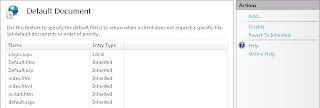Normally if the website's starting page is named as index.htm, index.html, default.aspx etc once you type your domain name in the address bar of the web browser it is able to browse the corresponding starting page. You don't need to specify the starting file name and extension. If your website's starting page is other than common use such as login.htm, login.aspx etc it not straight forward to resolve the starting page for a given website. For that you need to specify the default document for the website IIS using "Default Document" feature.
Fig 1: Default Document Icon
Browse the website that need to set the default document in "Connections" pane of IIS Manager. Double click on Default Document icon to specify the default document for your site.

Fig 2: Default Decument window in IIS 7.0
Click on "Add..." link to add new default document to the site. You can see in the figure there are two types of documents are listed. "Inheretted" items come from server level default documents and "Local" type entry is the specifically entered for this website.
Comments
Post a Comment